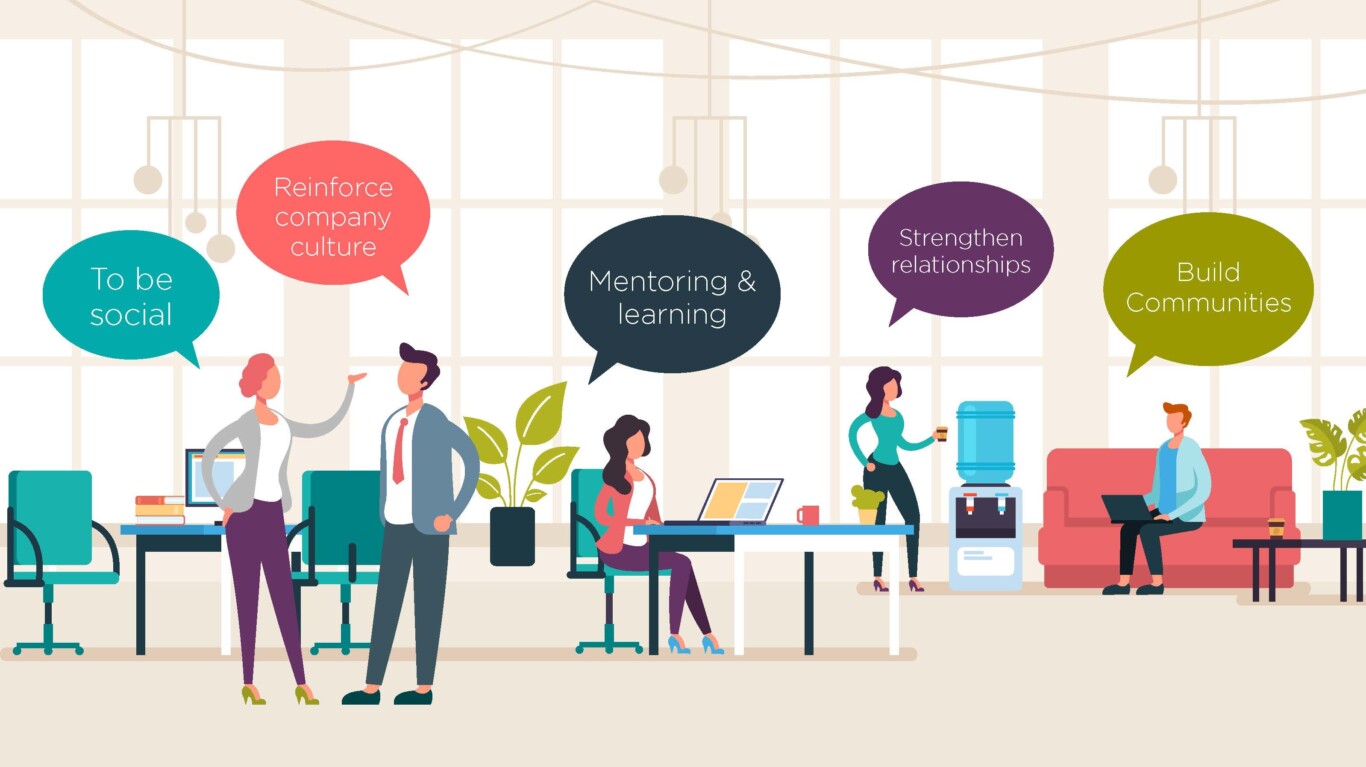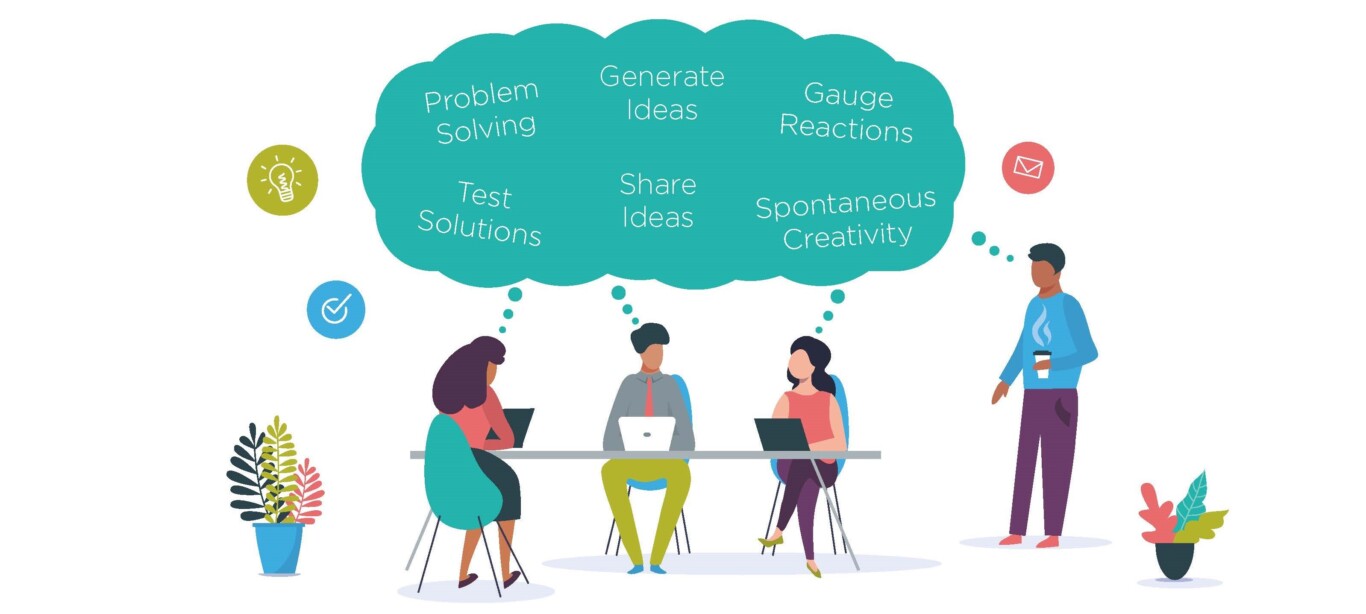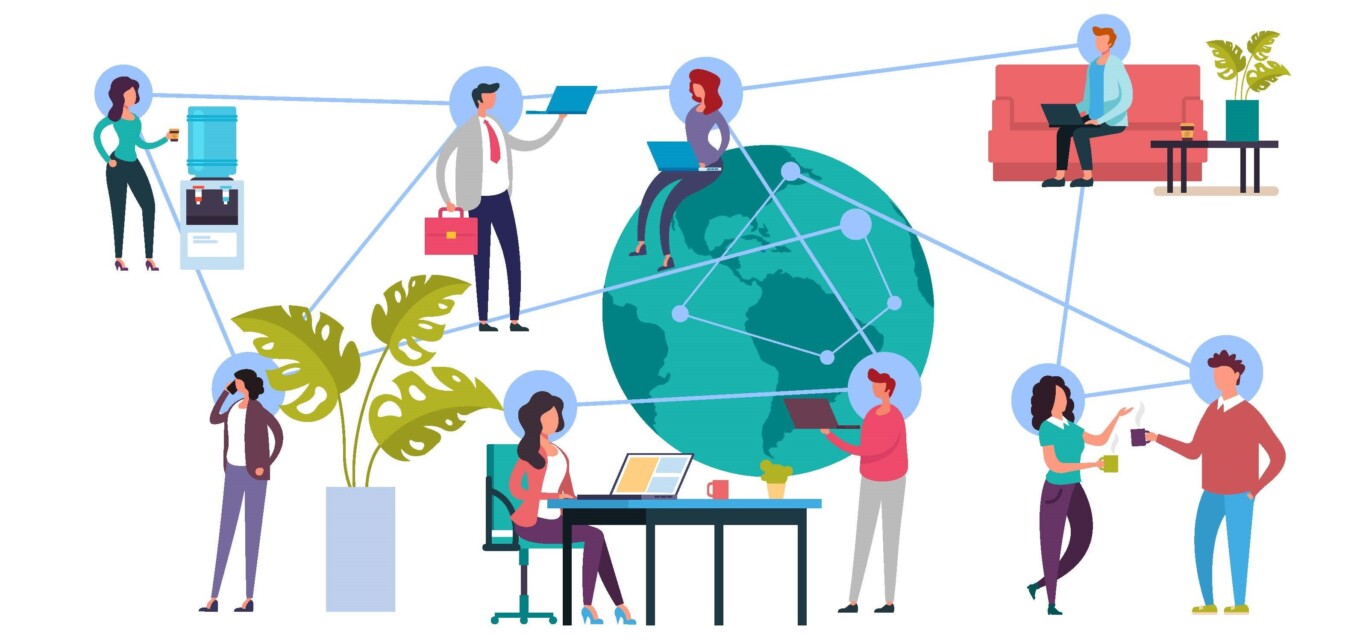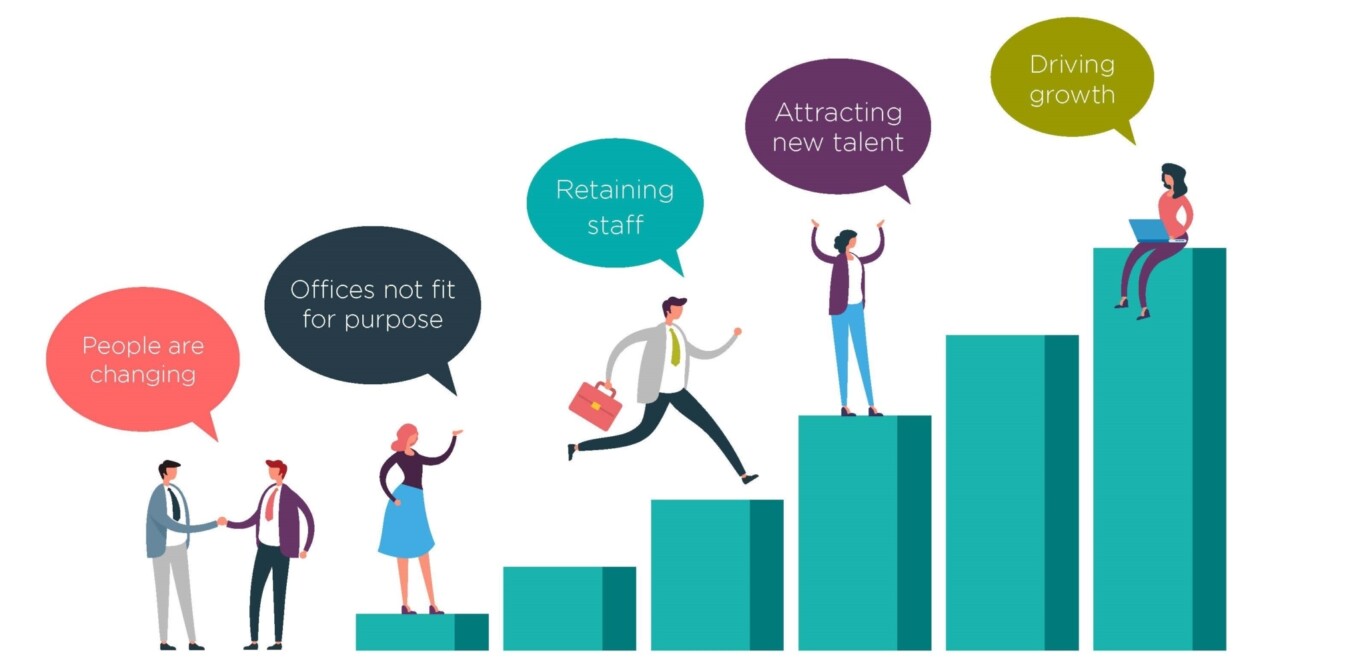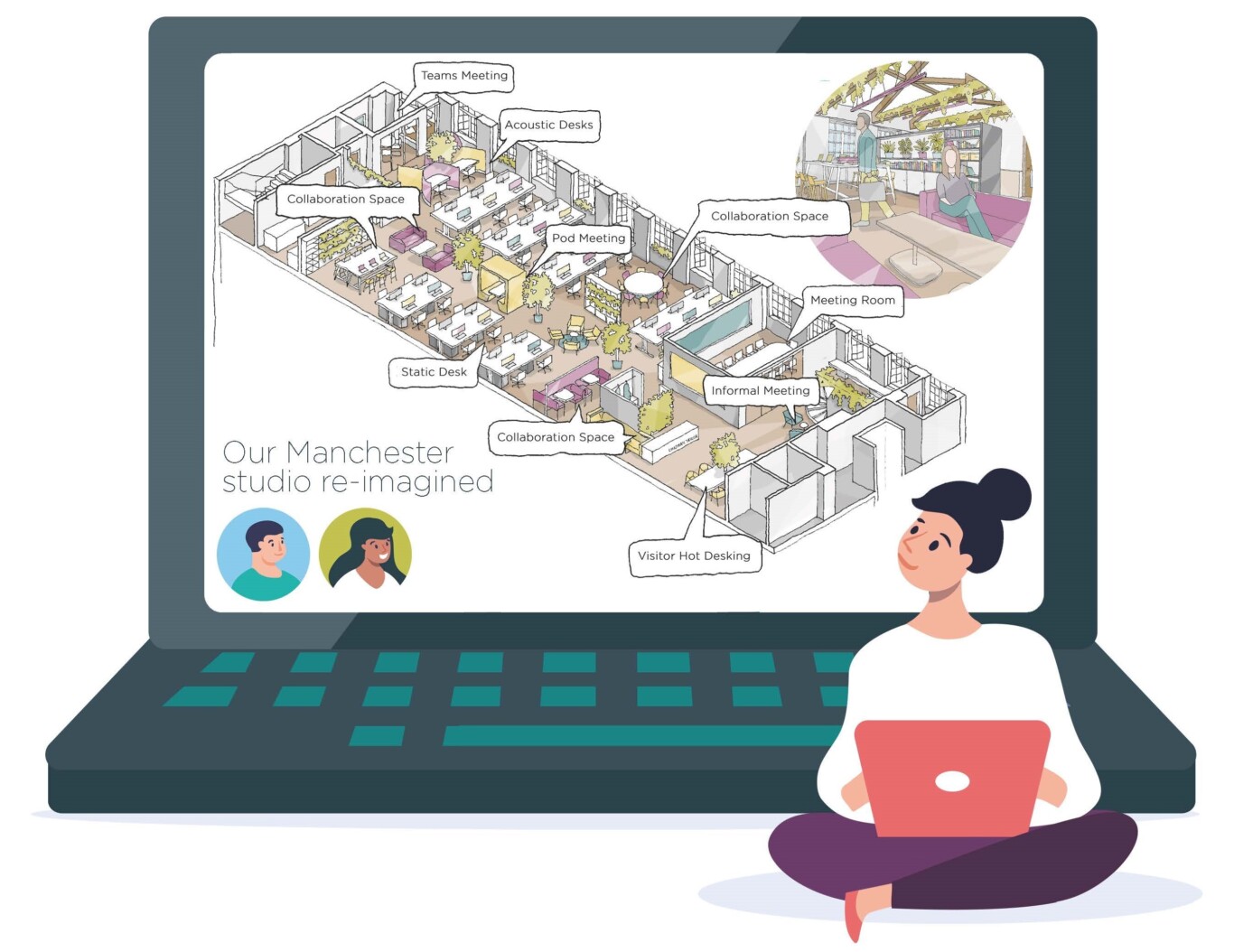
What is the future of the office, and how will it be impacted by working from home?
¿Cuál es el futuro de las oficinas y cómo se verá afectado por teletrabajar desde casa?
The COVID-19 pandemic has led many organisations and individuals to question the traditional workplace model where people commute every day to centralised offices, often in the centre of large cities and towns. The recent periods of enforced lockdown have caused many people to realise they can work from home, with the potential benefit of an improved work-life balance. As businesses now start to re-evaluate their workplace requirements, many are reviewing what the future holds for their office space.
In this paper, Associate Director and workplace design specialist Mark Doughty discusses the necessity for dedicated workplaces and explores the way in which landlords, employers and designers will need to adapt the traditional working model to embrace the lessons being learned and to strive for smarter and more agile work practices in the future.
La pandemia de COVID-19 ha llevado a muchas organizaciones e individuos a cuestionar el modelo de lugar de trabajo tradicional en el que las personas se desplazan todos los días a oficinas centralizadas, a menudo en el centro de las grandes ciudades y pueblos. Los recientes períodos de confinamiento han hecho que muchas personas se den cuenta de que pueden trabajar desde casa con el beneficio potencial de un mejor equilibrio entre el trabajo y la vida. Ahora que las empresas comienzan a reevaluar los requisitos de su lugar de trabajo muchas están revisando lo que depara el futuro para su espacio de oficina.
En este documento, el director asociado y especialista en diseño de oficinas, Mark Doughty, analiza la necesidad de lugares de trabajo exclusivos y explora la forma en que los propietarios, empleadores y diseñadores deberán adaptar el modelo de trabajo tradicional para aprovechar las lecciones aprendidas y esforzarse por lograr prácticas laborales más dinámicas en el futuro.
Enhancing the office with more agility and wellbeing-friendly design.
Mejorar las oficinas con flexibilidad y bienestar aplicado al diseño
COVID-19: A catalyst for change?
For decades, many people have travelled to and from their offices every day, often because this was the expectation of their employer. Virtually overnight, the recent pandemic has caused many to embrace remote working and both employers and employees are now realising there are potentially some tangible benefits to be gained from evaluating and embracing this model.
For some people, productivity has improved with, for example, fewer distractions when working from home and their commuting time being reallocated to work-focused tasks. Importantly, many people have noted an overall improvement in their work-life balance by managing their working day to accommodate more exercise and time with their families while still meeting their work requirements.
Conversely, some people have found their productivity has fallen, often because they have no suitable space to work, or because effective collaboration with their colleagues is simply not replicable over video conferencing, especially while juggling childcare arrangements or sharing home-working space with their partners or flatmates. The realisation for many is that the pandemic has underlined the importance of their workplace and, in particular, the non-work-related interactions that often happen there.
We should therefore expect to see more flexible ways of working in the future to address the needs of both the employer and employee. While many companies already offered a flexible working approach, the pandemic will accelerate a global change in workplace culture that looks to maximise the benefits of both the physical workplace and virtual remote working.
COVID-19: ¿catalizador del cambio?
Durante décadas muchas personas han viajado desde y hacia sus oficinas todos los días, a menudo porque esa era la expectativa de su empleador y obligaciones. Prácticamente de la noche a la mañana la pandemia reciente ha provocado que muchos adopten el trabajo a distancia y tanto los empleadores como los empleados se están dando cuenta de que pueden obtenerse algunos beneficios tangibles al evaluar y adoptar este modelo.
Para algunas personas la productividad ha mejorado con, por ejemplo, menos distracciones cuando trabajan desde casa y su tiempo de viaje se reasigna a tareas centradas en el trabajo. Es importante destacar que muchas personas han notado una mejora general en su equilibrio entre el trabajo y la vida al administrar su jornada laboral para acomodar más ejercicio y tiempo con sus familias sin dejar de cumplir con sus requisitos laborales. Por el contrario, algunas personas han descubierto que su productividad ha disminuido, a menudo porque no tienen un espacio adecuado para trabajar, o porque la colaboración efectiva con sus colegas simplemente no es replicable a través de videoconferencias, especialmente cuando hacen malabares con los arreglos del cuidado de los niños o comparten el espacio de trabajo en casa con sus socios o compañeros de piso.
Muchos se dan cuenta de que la pandemia ha subrayado la importancia de su lugar de trabajo y, en particular, las interacciones no relacionadas con el trabajo que a menudo ocurren allí. Por lo tanto, deberíamos esperar ver formas de trabajo más flexibles en el futuro para abordar las necesidades tanto del empleador como del empleado. Si bien muchas empresas ya ofrecían un enfoque de trabajo flexible, la pandemia acelerará un cambio global en la cultura del lugar de trabajo que busca maximizar los beneficios tanto del lugar de trabajo físico como del trabajo virtual remoto.
Why is the workplace important?
The office environment provides businesses and organisations with the opportunity to express their culture, strengthen relationships, be social and, ultimately, build a team-based community of people with a common set of objectives.
Mentoring of our younger staff, the future generations of our businesses, is also key within the office, not just for employers, but also for the development of the individuals themselves. Speaking from personal experience, I learned most of what I know by listening to, and learning from, those around me – picking up on snippets of telephone conversations or collaborating with peers. This does not happen when working in isolation. The office provides real life experiences and the ability to put into practice what has been learnt while still being able to draw on support from colleagues.
¿Por qué es importante el lugar de trabajo?
El entorno de la oficina brinda a las empresas y organizaciones la oportunidad de expresar su cultura, fortalecer las relaciones, ser sociales y, en última instancia, construir una comunidad de personas basada en equipos con un conjunto de objetivos comunes.
La tutoría de nuestro personal más joven, las futuras generaciones de nuestros negocios también es clave dentro de la oficina, no solo para los empleadores, sino también para el desarrollo de las propias personas. Hablando por experiencia personal aprendí la mayor parte de lo que sé escuchando y aprendiendo de quienes me rodean, captando fragmentos de conversaciones telefónicas o colaborando con compañeros. Esto no sucede cuando se trabaja de forma aislada. La oficina ofrece experiencias de la vida real y la capacidad de poner en práctica lo aprendido sin dejar de contar con el apoyo de colegas.
The office is also a destination, a reason to get out of bed every day, providing a much-needed structure to the working week. While, for some, commuting can be laborious, and time could potentially be better allocated to work-related tasks, the act of travelling to and from the office can often provide a valuable period of transition that contributes positively towards a more balanced state of mental wellbeing.
For creative businesses like ours, collaboration is a key part of our work. The office creates the opportunity to generate and share ideas collaboratively, solve problems, test solutions and immediately gauge people’s reactions. Evidence shows that many great innovations and creative sparks often happen almost accidentally within the workplace, or in the support spaces therein (e.g. the kitchen or breakout areas). These chance meetings are difficult to replicate on Zoom or MS Teams.
La oficina también es un destino, un motivo para levantarse de la cama todos los días, proporcionando una estructura muy necesaria a la semana laboral. Si bien, para algunos, los desplazamientos pueden ser laboriosos y el tiempo podría asignarse mejor a las tareas relacionadas con el trabajo, el hecho de viajar hacia y desde la oficina a menudo puede proporcionar un valioso período de transición que contribuye positivamente a un estado mental más equilibrado.
Para empresas creativas como la nuestra la colaboración es una parte clave de nuestro trabajo. La oficina crea la oportunidad de generar y compartir ideas de manera colaborativa, resolver problemas, probar soluciones y evaluar de inmediato las reacciones de las personas. La evidencia muestra que muchas grandes innovaciones y chispas creativas a menudo ocurren casi accidentalmente dentro del lugar de trabajo o en los espacios de apoyo en el mismo (por ejemplo, la cocina o las áreas de descanso). Estas reuniones casuales son difíciles de replicar en Zoom o MS Teams.
Getting around a table with colleagues is an invaluable creative opportunity.
Trabajar con personas alrededor de una mesa es una oportunidad creativa destacada
Striking a balance: Smart Working
We should recognise that more people than ever are now choosing to work remotely for some of the time (up from an estimated 20% pre-pandemic to over 50% currently in the UK) and, for some, things will not just return to the way they once were. Some people have been required to work from home in line with the Government’s or their employer’s guidance and will happily wish to return to the office once the pandemic restrictions are relaxed. Others are likely to want to use this period of remote working to re-evaluate how they wish to work in the future.
Many businesses, including ours, have started to review their office space requirements, and some may conclude that they can relinquish space if a significant number of their employees are able, and willing, to work remotely. If this flexible approach is planned and well-managed, it will present businesses with an opportunity to become more agile and attract talent from beyond the geographical location of their workplace. Of equal importance, their growth will no longer be limited by their physical tenant demise.
From an employee’s perspective, potential improvements in health and wellbeing and a better work-life balance will be a catalyst for this change. However, I strongly believe that the future of the workplace, and of workplace culture, lies in the balance to be struck between the needs of both the employer and their teams, i.e. Smart Working.
Lograr el equilibrio: Smart Working
Debemos reconocer que ahora más personas que nunca eligen trabajar de forma remota durante parte del tiempo (desde un 20% estimado antes de la pandemia a más del 50% actualmente en el Reino Unido) y, para algunos, las cosas no simplemente volverán a la normalidad como alguna vez fueron. A algunas personas se les ha pedido que trabajen desde casa de acuerdo con la orientación del gobierno o de su empleador y desearán felizmente regresar a la oficina una vez que se relajen las restricciones pandémicas. Es probable que otros quieran utilizar este período de trabajo remoto para reevaluar cómo desean trabajar en el futuro.
Muchas empresas, incluida la nuestra, han comenzado a revisar sus requisitos de espacio de oficina y algunas pueden concluir que pueden ceder espacio si un número significativo de sus empleados puede y desea trabajar de forma remota. Si este enfoque flexible está bien planificado y bien gestionado ofrecerá a las empresas la oportunidad de volverse más flexibles, dinámicas y atraer talento más allá de la ubicación geográfica de su lugar de trabajo. De igual importancia, su crecimiento ya no estará limitado por la desaparición de su inquilino físico.
Desde la perspectiva de un empleado las posibles mejoras en la salud y el bienestar y un mejor equilibrio entre el trabajo y la vida serán un catalizador para este cambio. Sin embargo, creo firmemente que el futuro del lugar de trabajo y de la cultura del lugar de trabajo radica en el equilibrio que debe lograrse entre las necesidades tanto del empleador como de sus equipos, es decir, el trabajo inteligente o “smart working”. Adoptar la conectividad digital para redefinir los límites físicos del lugar de trabajo.
Embracing digital connectivity to redefine the physical limits of the workplace.
Avanzando hacia la hiperconectividad para redefinir los límites físicos de las oficinas
First and foremost, businesses must function efficiently and effectively to be successful. The need for well-designed office space will continue to be vital to support an organisation’s dynamism and ability to collaborate and to host those all-important social and chance interactions with likeminded people. However, we should anticipate that changes to our workplace environments (both existing and new) will evolve more rapidly to support business culture while offering a smarter, more flexible and more attractive way of working for both employers and employees.
We also need to accept that some changes to the way we work may not suit everybody, so, however we choose to work in the future, we need to avoid a one-size-fits-all approach as well as any preconceived ideas about how people wish to work. We are all individuals with differing personal and business circumstances which change throughout our careers, and this will influence how we wish to work in the future. Working collaboratively with their employees, businesses will need to focus on evolving an office culture and environment that supports flexible working in a variety of ways.
En primer lugar las empresas deben funcionar de manera eficiente y eficaz para tener éxito. La necesidad de un espacio de oficina bien diseñado seguirá siendo vital para respaldar el dinamismo y la capacidad de una organización para colaborar y albergar esas importantes interacciones sociales y casuales con personas de ideas afines. Sin embargo, debemos anticipar que los cambios en nuestros entornos laborales (tanto existentes como nuevos) evolucionarán más rápidamente para respaldar la cultura empresarial al tiempo que ofrecerán una forma de trabajo más inteligente, flexible y atractiva tanto para los empleadores como para los empleados.
También debemos aceptar que algunos cambios en la forma en que trabajamos pueden no ser adecuados para todos, por lo que, independientemente de cómo decidamos trabajar en el futuro, debemos evitar un enfoque único para todos, así como cualquier idea preconcebida sobre cómo la gente desea trabajar. Todos somos personas con diferentes circunstancias personales y comerciales que cambian a lo largo de nuestras carreras y esto influirá en cómo deseamos trabajar en el futuro. Al trabajar en colaboración con sus empleados, las empresas deberán centrarse en desarrollar una cultura y un entorno de oficina que respalden el trabajo flexible de diversas formas.
What does this mean for the future of workplace design?
While we are some way off being “post-pandemic”, it is clear that the way we design or curate workplaces in the future should be with a view to being flexible and to meeting the specific needs of the people who work there. People are individuals with diverse needs, priorities and expectations. To avoid any preconceptions, the first step is to undertake a wide-ranging staff survey to collect accurate data and understand what is important to the people in the business. This can then be used to evolve a new workplace culture and allow us to deliver effective workplace design solutions.
As businesses re-evaluate their workspace requirements, one trend we are likely to see is a shift away from large, centralised office hubs in major cities, to a series of smaller satellite – or touchdown – spaces in more suburban and regional locations closer to where people live. These will provide the obvious benefit of reducing commuting times while also reducing the financial burden of occupying large swathes of premium office space in the centres of large cities.
Provision of more affordable, quality “local” office space as part of mixed-used town centre developments on the outskirts of primary cities will be key in the drive to regenerate our failing town centres while also reducing travel. These satellite office spaces could also be achieved using local co-working hubs, with subscriptions, to provide a degree of mobility and a choice of where to work.
¿Qué significa esto para el futuro del diseño de oficinas?
Si bien estamos un poco lejos de ser “post-pandémicos” está claro que la forma en que diseñamos o seleccionamos los lugares de trabajo en el futuro debe ser con miras a ser flexibles y satisfacer las necesidades específicas de las personas que trabajan allí. Las personas son personas con necesidades, prioridades y expectativas diversas. Para evitar ideas preconcebidas el primer paso es realizar una amplia encuesta al personal para recopilar datos precisos y comprender qué es importante para las personas en el negocio. Esto se puede utilizar para desarrollar una nueva cultura en el lugar de trabajo y permitirnos ofrecer soluciones de diseño de lugar de trabajo efectivas.
A medida que las empresas reevalúan sus requisitos de espacio de trabajo, es probable que veamos una tendencia que se aleja de los grandes centros de oficinas centralizados en las principales ciudades, a una serie de espacios satélites más pequeños, o de contacto, en ubicaciones más suburbanas y regionales más cercanas a donde la gente vive. Estos proporcionarán el beneficio obvio de reducir los tiempos de viaje y al mismo tiempo reducir la carga financiera de ocupar grandes extensiones de espacio de oficinas premium en los centros de las grandes ciudades.
La provisión de espacio de oficinas "local" más asequible y de calidad como parte de los desarrollos de centros urbanos de uso mixto en las afueras de las principales ciudades será clave en el impulso para regenerar nuestros centros urbanos en ruinas y al mismo tiempo reducir los viajes. Estos espacios de oficina satélite también podrían lograrse utilizando centros de trabajo como comunidades locales o asociaciones, con suscripciones, para proporcionar un grado de movilidad y una opción dónde trabajar.
Design for agility - a range of workplace environments for a range of different needs.
Diseño Flexible: una variedad de entornos de trabajo para una variedad de necesidades diferentes.
The current COVID crisis is a moment in time and is likely to become a distant memory in a few years. With vaccines now beginning to be distributed in the UK, things will soon begin to return to normality. However, it is important that the “new normal” does not simply revert to a pre-pandemic way of working and miss out on the opportunity to embrace the positive things we have learned about the way we can work more flexibly. We need to use our recent experience as a catalyst for positive changes to the way we work and use our workplaces, including the use of available and upcoming technologies and a renewed focus on health, wellbeing and the environments we work in.
Workplaces have never been just places to work; they are places for people to collaborate, to socialise, to mentor and learn and to foster health and wellbeing. For designers, our challenge is to ensure that the workplaces we design offer a stimulating environment to facilitate all these activities.
The new era of office needs to accommodate a wide variety of workspaces such as one-to-one meeting rooms, training areas, formal and informal collaboration spaces, and sit-stand desking. The key is to design these spaces to be as adaptable as possible and to facilitate more than one use.
Health and Wellbeing are now fundamental design considerations for architects, interior designers, developers, and tenants. Maximising natural light, the use of natural ventilation, designing in active circulation routes, providing abundant planting, and using biophilic and non-toxic materials are essential. New accreditations such as the WELL Building Standard will also become commonplace as tenants reinforce their commitment towards health and wellbeing of their staff.
La actual crisis de la COVID-19 es un momento en el tiempo y es probable que se convierta en un recuerdo lejano en unos años. Ahora que las vacunas comienzan a distribuirse en el Reino Unido, España y por medio mundo…, las cosas pronto comenzarán a volver a la normalidad. Sin embargo es importante que la “nueva normalidad” no vuelva simplemente a una forma de trabajo pre-pandémica y pierda la oportunidad de aceptar las cosas positivas que hemos aprendido sobre la forma en que podemos trabajar de manera más flexible. Necesitamos utilizar nuestra experiencia reciente como catalizador de cambios positivos en la forma en que trabajamos y usamos nuestros lugares de trabajo, incluido el uso de tecnologías disponibles y futuras y un enfoque renovado en la salud, el bienestar y los entornos en los que trabajamos.
Los lugares de trabajo nunca han sido solo lugares para trabajar: son lugares para que las personas colaboren, socialicen, orienten y aprendan así como se fomente la salud y el bienestar. Para los diseñadores nuestro desafío es garantizar que los lugares de trabajo que diseñamos ofrezcan un entorno estimulante para facilitar todas estas actividades. La nueva era de las oficinas debe adaptarse a una amplia variedad de espacios de trabajo, como salas de reuniones individuales, áreas de capacitación, espacios de colaboración formales e informales y escritorios para sentarse y parar un poco el día. La clave está en diseñar estos espacios para que sean lo más adaptables posibles y faciliten más de un uso.
La salud y el bienestar son ahora consideraciones de diseño fundamentales para arquitectos, interioristas, promotores, usuarios e inquilinos. Maximizar la luz natural, el uso de ventilación natural, diseñar en rutas de circulación activa, proporcionar una plantación abundante y utilizar materiales biofílicos y no tóxicos son esenciales. Las nuevas acreditaciones como WELL Building Standard también se convertirán en algo común a medida que los inquilinos refuercen su compromiso con la salud y el bienestar de su personal.
Why is change important?
As businesses begin to repopulate their workspaces, they may find that the way their offices are accessed, how circulation routes work and how the space is utilised, is no longer fit for purpose. This realisation could be a catalyst for undertaking major improvements to their work environment to create a new generation of safer, healthier, more flexible, and enjoyable spaces for staff to spend their time working in the offices as effective as possible.
The quality of the workplace is also an increasingly important factor in attracting and retaining the best talent in a business. Many successful businesses are already thinking in this way, and those who do not embrace Smart Working practices in the future will run the risk of becoming less attractive and competitive in what is a fast-changing and fluid employment landscape.
¿Por qué es importante el cambio?
A medida que las empresas comienzan a repoblar sus espacios de trabajo es posible que descubran que la forma en que se accede a sus oficinas, cómo funcionan las rutas de circulación y cómo se utiliza el espacio ya no es adecuada para su propósito. Este descubrimiento podría ser un catalizador para emprender importantes mejoras en su entorno de trabajo para crear una nueva generación de espacios más seguros, saludables, flexibles y agradables para que el personal pase su tiempo trabajando en las oficinas de la manera más eficaz posible.
La calidad del lugar de trabajo también es un factor cada vez más importante para atraer y retener al mejor talento en una empresa. Muchas empresas exitosas ya están pensando de esta manera y aquellas que no adopten las prácticas de trabajo inteligente en el futuro correrán el riesgo de volverse menos atractivas y competitivas en un panorama de empleo fluido y cambiante.
What is our aim at Chapman Taylor?
Our workplace team are currently conducting an extensive internal R&D study with our teams to help our understanding of “How do we want to work in the future?”.
Our starting point for this is a comprehensive survey of our staff with a series of pertinent workplace-related questions that will provide greater insight into the needs and aspirations of our colleagues and to help inform how we evolve the design of our studios and develop a Smart Working culture in the coming months and years.
Our objective is to refine our workplace environments, to work smarter, but most importantly to continue to embrace and respect Chapman Taylor’s core values and of servicing the needs of our clients to the best of our ability, within a strong and creative environment.
¿Cuál es nuestro objetivo en Chapman Taylor?
El equipo especialista en diseño de oficinas está llevando a cabo un extenso estudio interno de I + D con nuestros equipos internacionales para ayudarnos a comprender "¿Cómo queremos trabajar en el futuro?".
Nuestro punto de partida para esto es una encuesta integral de nuestro personal con una serie de preguntas pertinentes relacionadas con el lugar de trabajo que brindarán una mayor comprensión de las necesidades y aspiraciones de nuestros colegas y ayudarán a informar cómo evolucionamos el diseño de nuestros estudios y desarrollamos un concepto “Smart Work” cultural en los próximos meses y años.
Nuestro objetivo es perfeccionar nuestros entornos laborales, trabajar de manera más inteligente y eficiente pero lo más importante es continuar adoptando y respetando los valores fundamentales sociales, profesionales e inclusivos de Chapman Taylor atendiendo las necesidades de nuestros clientes lo mejor que podamos, dentro de un entorno creativo, creíble, colaborativo y alegre.
